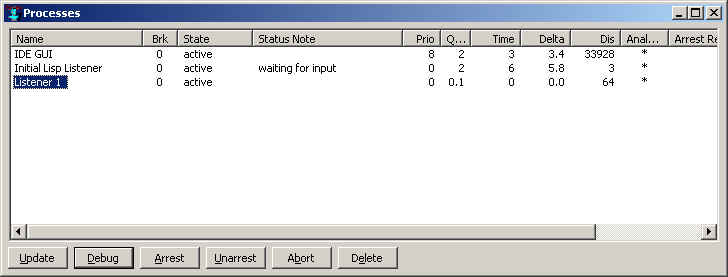Process
The process dialog displays information about the processes within
Lisp. See multiprocessing.htm for information on
processes. It is displayed with the View | Processes menu item.

Click on the Update button to update the display. It is not
updated automatically.
The Headings
-
Name: The name of the process
-
Brk: The break level of the process. A process enters a higher
break level when an error is signaled but not handled. Other
conditions, when signaled, may put a process in a break level under
certain circumstances (when
*break-on-signals* is true, e.g.) Break level 0
means no unhandled error or condition.
-
State: The state of the process (active, runnable, waiting, etc.)
-
Status Note: The "whostate" of the process (as returned by
process-whostate). While the value
can be any string, it usually describes what the process is doing.
-
Prio: The priority of the process.
-
Quantum (Q... in the illustration): The process quantum.
-
Time: the (approximate) total cpu time consumed by the process.
-
Delta: The cpu time consumed since the last report.
-
Dis: The number of times the process has been resumed since the last
report.
-
Analyzable (A... in the illustration) A * in the column
indicates the process can be included in a runtime analysis (see
runtime-analyzer.htm.
-
Arrest Reasons the arrest reasons (as returned by process-arrest-reasons) of the
process.
The buttons
-
Update: update the display.
-
Debug: display the process stack backtrace in the debug window.
-
Arrest: Arrest the process for arrest reason "debugging".
-
Unarrest: Remove (if possible) the arrest reasons of the process.
-
Abort: Unwind the process thread clearing all errors and break levels.
-
Delete: Kill (and delete) the process.
See also the top-level command :processes.
Copyright (c) 1998-2016, Franz Inc. Oakland, CA., USA. All rights reserved.
This page was not revised from the 8.1 page.
Created 2010.1.21.

